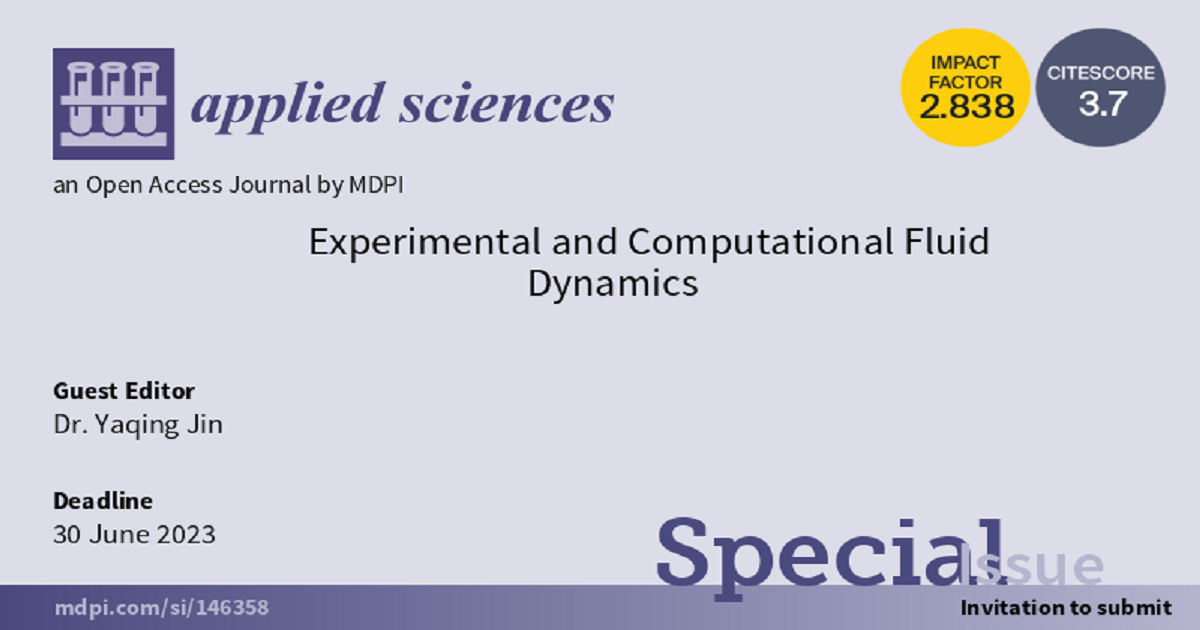Experimental and Computational Fluid Dynamics
A special issue of Applied Sciences (ISSN 2076-3417). This special issue belongs to the section "Fluid Science and Technology".
Deadline for manuscript submissions: closed (30 June 2023) | Viewed by 7623

Special Issue Editor
Interests: fluid mechanics; renewable energy; fluid–structure interactions; turbulent flow; energy-efficient locomotion
Special Issues, Collections and Topics in MDPI journals
Special Issue Information
Dear Colleagues,
Fluid dynamics are relevant to many aspects of engineering applications, including wind energy, hydroelectric power, and the transport of oil/gas in pipelines, among others. Understanding the fundamental mechanisms of fluid dynamics in different engineering fields plays a key role in improving the efficiency of energy production and the lifespan of the facilities. This Special Issue entitled “Experimental and Computational Fluid Dynamics” provides an open access forum focusing on the state-of-the-art advances in different areas of fluid mechanics and their applications in engineering fields. The scope of this Special Issue includes (but is not limited to) both experimental and computational works for fluid dynamics across multiple scales, including advanced flow diagnostic tools and computational approaches, and how such advancements improve our knowledge of fluid dynamics in different engineering applications.
This Special Issue aims to provide opportunities for research scholars, scientists and engineers to share and discuss both their original research works and reviews on relevant topics. Studies on the strong connection between underlying fluid dynamic mechanisms and their applications in engineering fields are highly welcome.
Dr. Yaqing Jin
Guest Editor
Manuscript Submission Information
Manuscripts should be submitted online at www.mdpi.com by registering and logging in to this website. Once you are registered, click here to go to the submission form. Manuscripts can be submitted until the deadline. All submissions that pass pre-check are peer-reviewed. Accepted papers will be published continuously in the journal (as soon as accepted) and will be listed together on the special issue website. Research articles, review articles as well as short communications are invited. For planned papers, a title and short abstract (about 250 words) can be sent to the Editorial Office for assessment.
Submitted manuscripts should not have been published previously, nor be under consideration for publication elsewhere (except conference proceedings papers). All manuscripts are thoroughly refereed through a single-blind peer-review process. A guide for authors and other relevant information for submission of manuscripts is available on the Instructions for Authors page. Applied Sciences is an international peer-reviewed open access semimonthly journal published by MDPI.
Please visit the Instructions for Authors page before submitting a manuscript. The Article Processing Charge (APC) for publication in this open access journal is 2400 CHF (Swiss Francs). Submitted papers should be well formatted and use good English. Authors may use MDPI's English editing service prior to publication or during author revisions.
Keywords
- fluid dynamics
- flow diagnostic tools
- computational fluid dynamics
- multiscale fluid dynamics
- fluid dynamics in engineering
Benefits of Publishing in a Special Issue
- Ease of navigation: Grouping papers by topic helps scholars navigate broad scope journals more efficiently.
- Greater discoverability: Special Issues support the reach and impact of scientific research. Articles in Special Issues are more discoverable and cited more frequently.
- Expansion of research network: Special Issues facilitate connections among authors, fostering scientific collaborations.
- External promotion: Articles in Special Issues are often promoted through the journal's social media, increasing their visibility.
- Reprint: MDPI Books provides the opportunity to republish successful Special Issues in book format, both online and in print.
Further information on MDPI's Special Issue policies can be found here.





